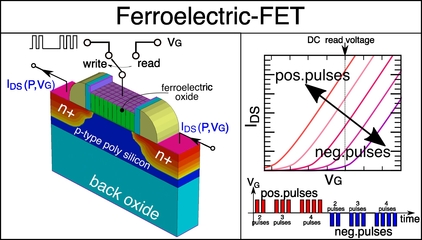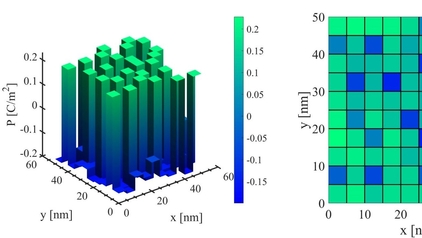

Memristors and neuromorphic computing
Neuromorphic computing is an electronic engineering field which aims at emulating with modern nanoelectronic devices and circuits some of the building blocks and working principles of biological cognitive systems, such as synapses, neurons, biological neural network topologies and plasticity mechanisms. In this sense, neuromorphic devices, circuits and systems can be regarded as an attempt to realize neural networks directly in hardware.
In fact, the demand for energy efficient hardware platforms for artificial intelligence has raised a growing interest for memristive devices capable of implementing non volatile, multi–level conductance features. Prominent applications of such synaptic devices are crossbar arrays for artificial deep neural networks, and hybrid memristive–CMOS circuits for spike–based neuromorphic computing.
The ferroelectric polarization switching is driven by the electric field (as opposed to a current flow), which makes ferroelectric materials very attractive as highly energy efficient memristors. In this respect, the small tunneling read current qualifies Ferroelectric Tunnel Junctions (FTJs) as high–impedance and low–energy, two-terminal synaptic devices. Moreover, Ferroelectric transistors (FeFETs) provide three-terminal artificial synapses, where the transistor current can probe the polarization state in the device and provide a wide range of equivalent conductance for the artificial synapse.
In this framework, our group is involved in modelling and design activities regarding both FTJs and FeFETS, which being carried out in collaboration with several international partners and in the framework of the H2020 European Project BeFerroSynaptic (H2020, GA: 871737) http://www.beferrosynaptic.eu/
Multilevel Operation in Scaled Back-End-of-Line Ferroelectric FETs With a Metal Interlayer
C. Rossi, D. Lizzit and D. Esseni, IEEE Access, vol. 13, pp. 68525-68535, 2025.
A Novel Ferroelectric MemCapacitor Enabling Multilevel Operation
D. Lizzit, M. Segatto and D. Esseni, IEEE Transactions on Electron Devices, vol. 72, no. 3, pp. 1083-1090, 2025.
Adiabatic Leaky Integrate and Fire Neurons with Refractory Period for Ultra Low Energy Neuromorphic Computing
M. Massarotto, S. Saggini, M. Loghi, D. Esseni. npj Unconventional Computing, 1, p. 15, 2024.
Novel Experimental Methodologies to Reconcile Large- and Small-Signal Responses of Hafnium-based Ferroelectric Tunnel Junctions
M. Massarotto, F. Driussi, A. Affanni, S. Lancaster, S. Slesazeck, T. Mikolajick, D. Esseni. Solid-State Electronics, vol. 200, p. 108569, 2023.
Neuromorphic object localization using resistive memories and ultrasonic transducers
F. Moro, E. Hardy, B. Fain, T. Dalgaty, P. Clémençon, A. De Prà, E. Esmanhotto, N. Castellani, F. Blard, F. Gardien, T. Mesquida, F. Rummens, D. Esseni, J. Casas, G. Indiveri, M. Payvand, E. Vianello. Nature communications 13, 3506, 2022.
Charge-Trapping-Induced Compensation of the Ferroelectric Polarization in FTJs: Optimal Conditions for a Synaptic Device Operation
R. Fontanini, M. Segatto, K. S. Nair, M. Holzer, F. Driussi, I. Häusler, C. T. Koch, C. Dubourdieu, V. Deshpande, D. Esseni. IEEE Transactions on Electron Devices, vol. 69, p. 3694, 2022.
Interplay Between Charge Trapping and Polarization Switching in BEOL-Compatible Bilayer Ferroelectric Tunnel Junctions
R. Fontanini, J. Barbot, M. Segatto, S. Lancaster, Q. Duong, F. Driussi, L. Grenouillet, L. Triozon, J. Coignus, T. Mikolajick, S. Slesazeck, D. Esseni, IEEE Journal of the Electron Devices Society 10, 593-599, 2022.
Limitations to Electrical Probing of Spontaneous Polarization in Ferroelectric-Dielectric Heterostructures
M. Segatto, R. Fontanini, F. Driussi, D. Lizzit, D. Esseni. IEEE Journal of the Electron Devices Society, 10, 324-333, 2022.
Modeling and design of FTJs as multi-level low energy memristors for neuromorphic computing
R. Fontanini, M. Segatto, M. Massarotto, R. Specogna, F. Driussi, M. Loghi, D. Esseni. IEEE Journal of the Electron Devices Society, 9, 1202-1209, 2021.

